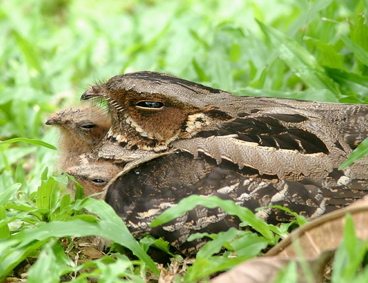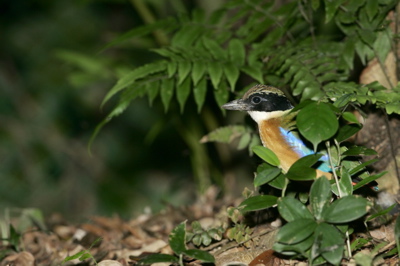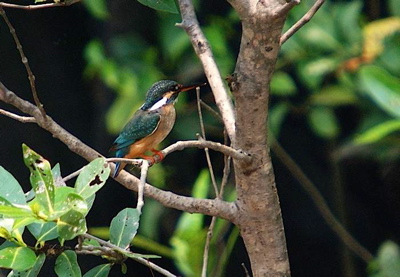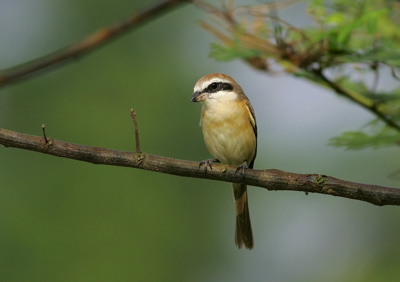“The Grey Nightjar (Caprimulgus indicus) is an uncommon but annual migrant to Singapore. It breeds from northern Thailand all the way up to Siberia. Like the Oriental Scops Owl (Otus sunia) it is a nocturnal bird that is usually silent away from it’s breeding grounds. In recent years, a few birds have been observed throughout the “winter” period (October – March) around the MacRitchie and Sime Forest areas of the Central Catchment Nature Reserve, proving that the species winters here. One to two birds have wintered around the Treetop Walkway area for the past two years or so and have been seen and photographed, during the day, roosting on branches of adjacent trees.
“In all my years of local bird observation, I have only heard this nightjar calling twice… at Sentosa. Calling may be an indication that the bird is holding a winter territory.
“On November 16th, 2006, while conducting an evening bird survey at the Treetop Walkway (above), I was pleased to hear a Grey Nightjar calling loudly at dusk. The call was a quickly repeated “tuc” note in a series of several in a row. The call was coming from a large Terentang tree (Campnosperma auriculatum) where this species has been regularly seen roosting before. Along with Benjamin Lee and Janet Hong, who were with me at the time, we quickly moved closer. What followed was both unexpected and exciting.
“The calling Grey Nightjar was being harassed by a resident Large-tailed Nightjar (Caprimulgus macrurus) (above). The latter may not have been pleased about this visitor calling loudly within what it considered it’s territory. Instead of retreating and going silent, as expected, the Grey chased off it’s larger cousin before returning to the tree to call loudly from a branch. This scene was replayed twice or thrice more, before the Grey chased the Large-tailed away. We could see the chase below us before they both disappeared into the darkness. Subsequently, the Grey was heard calling loudly again from a different tree.
“What can we make of this scene and the behaviour witnessed? Well, many migrants do not call because they are not at their breeding grounds defending their territory or seeking a mate. However, there are many others who call constantly while here. Why the difference? In many cases, this may be the difference between passage migrants and wintering visitors.
“A passage migrant simply passes through Singapore, on its way to further south… probably Indonesia. They may stop to feed for a few days or if the weather is unfavourable (as well as when there is a thick haze in the way) but they do not stake out a feeding territory for their short stint here, hence no need to call. Some, like the Yellow-rumped Flycatcher (Ficedula zanthopygia), may stopover for a bit longer and sets up a temporary territory by calling from selected perches. Others, like the Blue-winged Pitta (Pitta moluccensis) (above) only call once or twice, at dawn or dusk… contact call to any of their kind that may be about? Who knows?
“A winter visitor actually spends the cold northern winter here in tropical Singapore, often staying a few months before returning to their breeding grounds in spring. As they are here for quite a while, they set up a territory in which they feed and sometimes drive away others of their kind, like the Common Kingfisher (Alcedo atthis) (above) does. Throughout the “winter” months (this period varies from species to species), we are treated to the calls of Arctic Warblers (Phylloscopus borealis), Asian Brown Flycatchers (Muscicapa dauurica), Brown Shrikes (Lanius cristatus) (below), Siberian Blue Robins (Luscinia cyane) and many, many more northern visitors.
“So, the calling and aggression displayed by the Grey Nightjar on Thursday may simply be further proof that this species is now a winter visitor in Singapore.”
Submitted by Subaraj Rajathurai, 18th November 2006
Images by YC (Treetop Walkway), Chan Yoke Meng (Blue-winged Pitta, Brown Shrike), KC Tsang (Common Kingfisher) and Tang Hung Bun (Large-tailed Nightjar).














2 Responses
good pictures and summary! thanks a lot for your information!
My husband and I have been visiting Singapore and did the MacRitchie Treetop walk this morning. We believe we saw a grey nightjar. Not far in to the suspension walk, there is a dead tree on the left hand side of the walk, quite close to the railngs. The tree has some lopped branches as well as a branch that ends in a hollow-log at the end. We saw and photographed the bird there – very well camouflaged and matching the buff/grey tones of the dead wood.